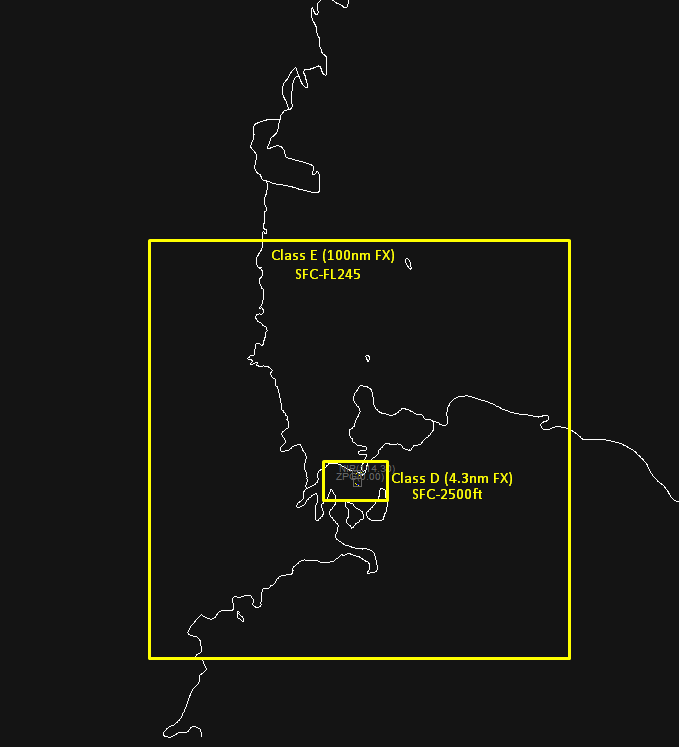Phoenix Field Tower
Section 1:
1.1 - Responsibilities
Phoenix Field Tower is responsible for providing air traffic control services to aircraft within Class D, airspace non-radar arrival and departure services in Class E airspace, traffic advisories and Air Traffic Control service for VFR and IFR aircraft within Class D and E airspace, air traffic control service to aircraft within Class D airspace.

1.2 - Frequency and Callsign Information
| Callsign | NZFX_TWR |
| Primary Frequency | 126.200 MHz |
| RTF Designator | Pheonix Field Tower |
| Telephone Designator | Pheonix Field Tower |
1.3 - Clearances/Departure Procedures
Clearances issued by the tower controller should be in FAA phraseology or VATNZ standard phraseology. VFR Phraseology can remain the same inline with VATNZ phraseology.
1.3.1 - Departure Procedures
- IFR aircraft will call for IFR clearance. Tower will relay IFR clearances and issue departure instructions to aircraft departing on an IFR flight plan.
- VFR aircraft will be given appropriate VFR departure information.
1.3.2 - FAA IFR Clearance Phraseology
CLEARED TO (destination) AIRPORT;
and as appropriate,
(SID name and number) DEPARTURE,
THEN AS FILED.
When the SID does not contain published crossing restrictions and/or is a SID with a Radar Vector segment or a Radar Vector SID; or is a SID with a radar vector segment and contains published crossing restrictions after the vector segment.
MAINTAIN (altitude); (additional instructions or
information).
Or when a SID contains published crossing restrictions,
CLIMB VIA SID.
CLIMB VIA SID EXCEPT MAINTAIN (altitude); (additional instructions or information).
If a SID is not assigned,
CLEARED TO (destination) AIRPORT AS FILED.
MAINTAIN (altitude);
and if required,
(additional instructions or information).
1.4 Classes of Airspace
As Mac Center is controlled in the real world by American Military Controllers, controllers from VATNZ should be aware of the different classes of airspace and what they mean.
1.4.1 Class A
Within the McMurdo Sector, applicable to all aircraft, includes the airspace beginning at Flight Level 245 up to and including Flight Level 600.
1.4.2 Class D
The area around the operating control tower at Pheonix Field is designated Class D airspace. The area is a 4.3 NM (5 SM) radius from the center of the airport surface up to and including 2500 AGL. Two-way radio contact with the control tower is mandatory prior to entering Class D airspace.
1.4.3 Class E
Class E airspace is controlled airspace within 100 NM of Williams Field, or Pegasus Field TACANs (excluding Class D airspace) extending from the surface up to, but not including, FL 245.
In Class E airspace, the following traffic services are provided by ATC:
- IFR flights provided with an ATC service are separated from other IFR flights
- IFR flights receive information about VFR flights as far as practicable
- VFR flights receive flight following where available on request and
- Hazard alerts will be directed to pilots of known VFR flights.
Traffic information services provided by ATC do not relieve pilots of their responsibilities for continued vigilance to see and avoid other aircraft.
VFR flights entering Class E airspace do not require a clearance. VFR flights entering and operating in Class E airspace should:
- avoid published IFR routes, where possible
- monitor the appropriate Class E frequency and announce if in potential conflict
- take appropriate action to avoid potential conflict and
- avoid IFR holding patterns.
1.5 - Transfer of Communications
Airbourne aircraft should be handed over to UNICOM on 122.8 or told to continue with Mac Center if they are online. Pheonix Field Tower also provides a non-radar approach service for aircraft in Class E airspace and Class D airspace. Aircraft operating in Class D airspace will be in radio contact with the tower and should remain at 1,000 feet AGL or higher (500 feet for helicopters) until commencing final descent. VFR. Aircraft are normally instructed to contact tower no closer than 10 miles from the airport for landing instructions

